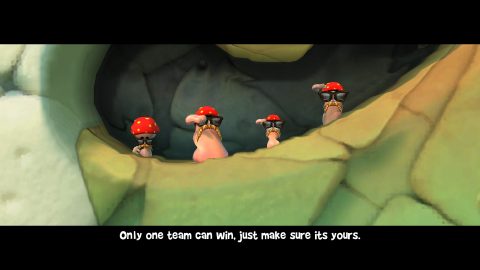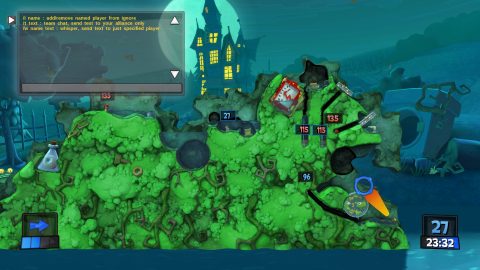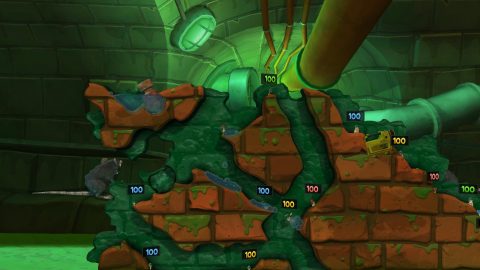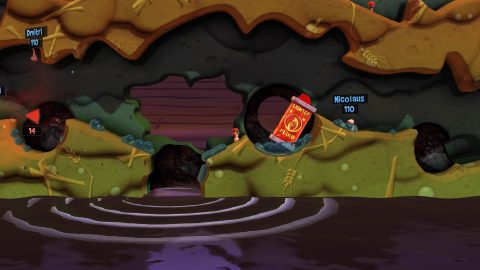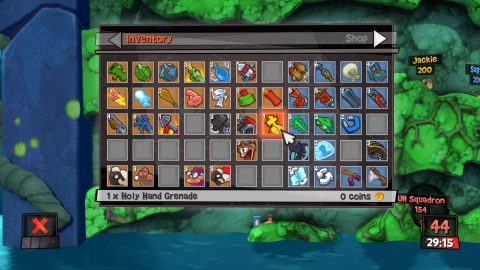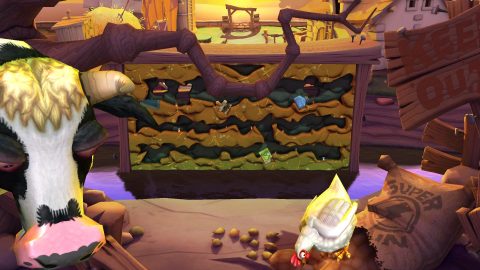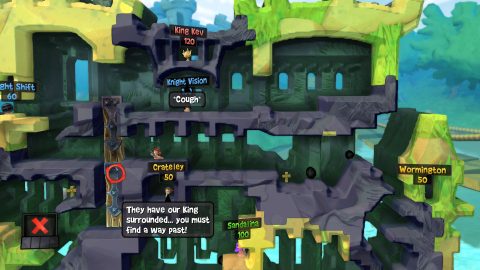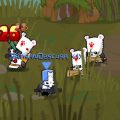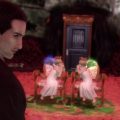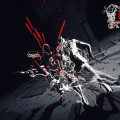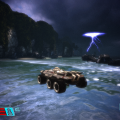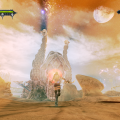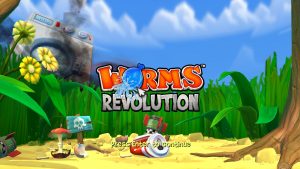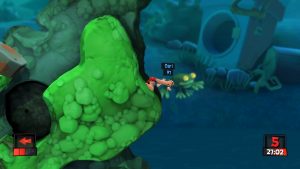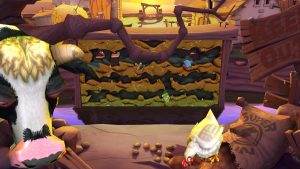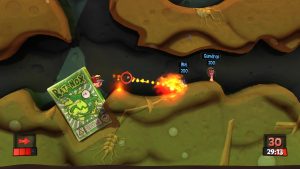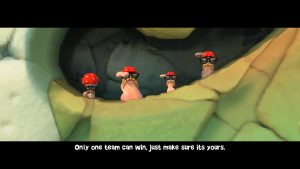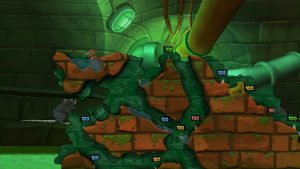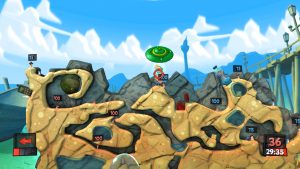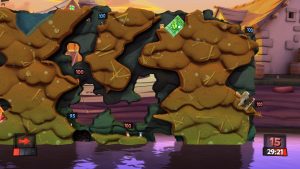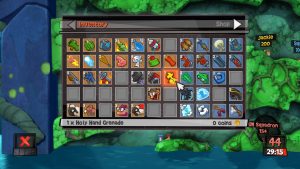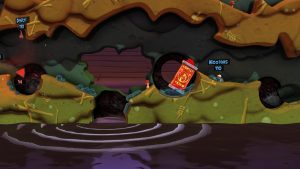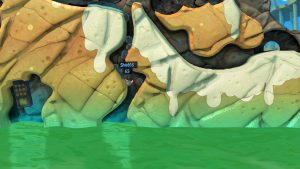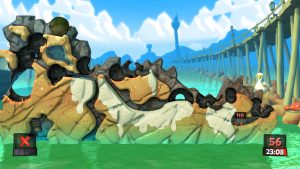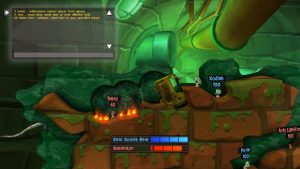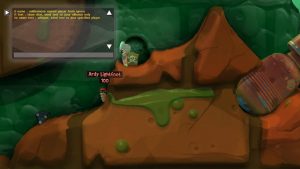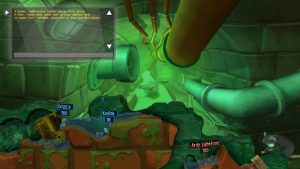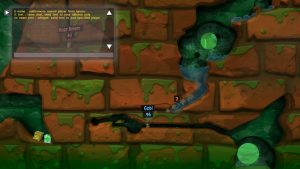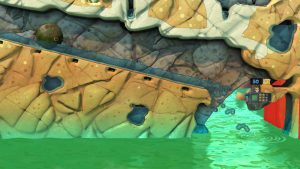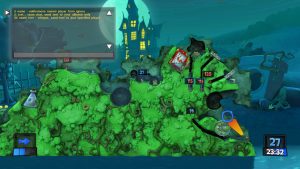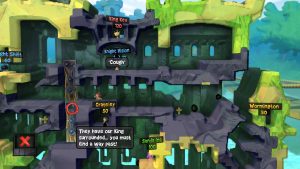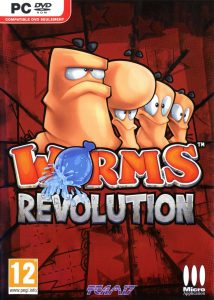- Worms
- Worms: Reinforcements
- Worms: The Director’s Cut
- Worms 2
- Worms Pinball
- Worms Armageddon
- Worms World Party
- Worms Blast
- Worms 3D
- Worms Forts: Under Siege
- Worms 4: Mayhem
- Worms: Open Warfare
- Worms: Open Warfare 2
- Worms 2 – Armageddon / Worms Reloaded
- Worms: A Space Oddity
- Worms: Battle Islands
- Worms Crazy Golf
- Worms Revolution
- Worms Rumble

European PC Cover
Worms Crazy Golf was somewhat of a break in a series that had seemed to lose its focus and creativity alike, one dull release at a time. Entries like Open Warfare 2 were acceptable for handhelds, while releases like Worms 2: Armageddon felt more like obligations from Team 17 than real passion works. While Revolution still never really struck the spark Armageddon did, those many long years ago, it does feel, at the very least, like an attempt at doing something new and fresh with the brand. Unfortunately, few, if any of its shotgun blast of ideas really manage to hit the mark. Credit has to be given for effort, at least.
The first thing the game makes front and center from its logo is that worms can now take one of four different classes, each of which offers its own strengths and weaknesses. How it works is somewhat strange – you have to ‘buy’ worms of each of the four classes with in-game money, with the price going up for its type each time you purchase one. Depending on how many worms you want on the field, it can take some time to build up the exact sort of team you may want. In the days when the game was new, this would mean you’d have to work your way through the single player before you really got the chance to experiment with different team builds. Nowadays, now that the game’s time has passed, it’s not as much of an annoyance, since you’ll likely get more out of the single player component anyways.
Soldiers are worms as we know them, with no special strengths or weaknesses. Heavies are far slower and much worse at jumping, making it much harder for them to get place to place without help. They are, however, much harder to push around through explosions, and send enemy worms much further through melee attacks. Scouts are their opposite, moving faster, jumping higher, and making paths with the blow torch other worms can’t follow them in. However, they do less damage with all weapons and get flung around with much more force, making hazards and drops much more of a problem for them.
The most potentially troublesome of worms, however, are the scientists. Any sentry guns and girders they place withstand more damage, and their magnets will never run of power. Because of this fact alone, they’re ideal when sequestering themselves behind an assortment of defenses, especially with how deceptive the range on sentry guns actually tend to be. Even worse than that, however, is that each time a scientist takes a turn, every worm on their team gains a small amount of health. These traits encourage dark side play (a somewhat frowned upon tactic involving digging deep tunnels and adding in turrets, girders, and other defenses that prevent your enemies from reaching you) like never before, and it’s hard to ignore the temptation to bury your scientist somewhere deep and let him keep your frontliners alive.
The classes do add some thought to what you’re doing – each excels at one particular thing, so the more of one type you have, the more you can focus on that particular playstyle. Heavies are best at closing into melee range, since they have less to fear from being knocked into a hazard, while scouts work best with hit and run strategies. Having a mix of classes isn’t essential – it’s perfectly possible to have a team of soldiers and do well enough. If you have a preferred style, however, the classes make for a good way of assisting it. Woe be to your friendships if you’re the sort of darksider who intends to use the scientist to drag a match out to the bitter end, however.
Also new is “dynamic” water – so named because it’s different from the liquid that claims worms who fall to the bottom of the map. This type of water can be found in pools and wells throughout most maps, and can also be spawned forth with some of the new weapons. Once there’s nothing containing it, water will move, flow, and pool in the manner you’d expect water to move. A worm who gets entirely submerged won’t suffer instant death, but they will gradually lose health each turn that passes. Exactly how dangerous this can be varies – a worm at the end of a flooded tunnel without the tools to make their way out may be in for a slow death.
Water can also be used to push objects and worms alike around the map, if there’s enough of a current. A sudden flood can be useful for shoving a mine or sentry gun somewhere it might be more of use. The liquid is also just about custom-made for shoving worms off a cliff and towards the edge of the battlefield, as even a small flood will send them scrambling away with the current. It’s a very situational addition, overall – while water will hamper a worm’s jumping capabilities, you still have to make sure it’s put to use in places worms can’t just leap their way free or teleport themselves away from a watery grave.
Along with water, maps also usually have several physics objects, usually found buried in the dirt. They come in various shapes, and should they be unwedged from the ground, they can be moved around as you’d expect from their shape. Round objects will roll down slopes, while horizontally-shaped things can tip over and possibly block off exit routes. Generally, they don’t generally get in the way of the worms too much – even if an object falls on top of a worm’s head, they can generally get around it by jumping against it, pushing it upwards enough that they can scoot their way out from under it. They can make good mobile cover in a pinch, though, and there are rare times when you can wedge an object somewhere just tight enough that it’s not quite so easy to push out of the way.
Most of these objects also do something once they’ve taken enough damage, as denoted by their color. Blue objects release water, red ones explode, while green objects release clouds of poison gas that slowly drain the life of affected worms. Using these objects in actual combat is a little bit of a double-edged sword – they usually take a couple of bazooka shells worth of damage before they’ll pop, which means the safer ones can make reliable cover. If you’re hoping to use one of the deadlier items against your foes, you’ll often have to weigh the decision of if it’s worth using a turn tto damage it just a little bit, or go for a more direct attack. The “regular” objects, however, don’t really feel like they have enough of an effect, given how often enemy worms can simply maneuver around them.
The entire game feels eager at every chance it can get to show off its fancy new physics engine, and there are times when it can be more trouble than it’s worth. There are times when they’ll kick in and screw up a well-laid plan in an unfair fashion. If you place a sentry gun on a slope, there’s a high chance it’ll simply roll right down the hill and into the waters below, with nothing you can do about it. Other times, a crate will spawn on the edge of a cliff, tipping over just enough to send it hurtling into the depths. It adds a degree of randomness that, unlike the wind, can’t be accounted for in your plans, making devising any more strategy much more difficult. It’s also not entirely rare to see the physics break entirely, causing strange collision bugs when they do.
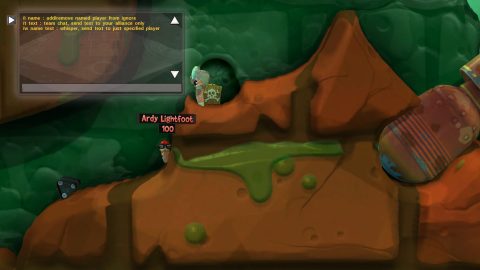
That sentry gun’s gonna keep on rolling until it falls into the sewer waters below. You’re not getting it back.
Of course, there’s also the assortment of new items and weapons to make use of, many of which factor in the game’s new features. Water can be added to the field in gun, grenade, and airstrike forms, along with a plug hole that can be placed to help remove some of it. Certain utilities will also let you pick up physics objects and place them somewhere else – but not objects such as mines or sentry guns, which might be more immediately helpful. Along the usual health, weapons, and utility crates, a new addition are coin crates. Somewhat confusingly, these don’t tie into the coins you use to buy more worms for your team, but are rather used in the match to purchase extra ammunition for whatever you’re running low on. Like a lot of the game’s ideas, it’s somewhat half-baked – in most cases, you’ll only get the money to buy an extra shot or two, at most.
In an annoyance that would carry over from Worms 2: Armageddon, the game also locks several weapons behind DLC, including weapoms not seen since 2001’s World Party. While none of these extra weapons are anything you won’t be able to live without, it’s a clear case of nickel and diming that can make the game feel incomplete without shelling out.
Rounding out the package is the usual Worms single-player mode, which works as it has since the days of Open Warfare 2. Clear several deathmatch missions with a pre-selected layout and loaded, and then complete a puzzle focused “boss” stage to unlock the next set of missions. In lieu of cutscenes, all missions are now opened and closed by an unseen narrator by the name of “Don Keystone”. Obstensibly a wildlife documentarist, he’s mostly there to provide a lot of typically Brtish sarcasm and non-sequiters, occasionally mixed in with the rare hint. His quips are at least modestly funny, although they oftentimes end up running together the further through the campaign you go.
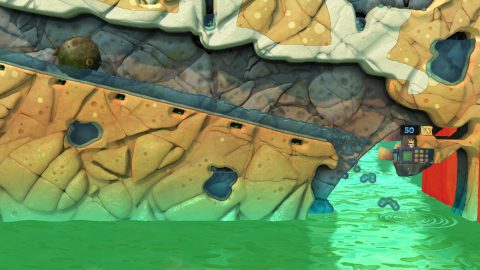
This flood will wash all the turrets in its path into the ocean below. You’ll have to find another way around the mines.
The graphics engine has also received a major upgrade, with everything now being depicted from a “2.5D” viewpoint. In terms of looks, it holds up pretty well, with the big-eyed, floaty-handed worms being just as emotive as ever. Unfortunately, there’s only four different map themes, and while they’re distinctive enough, it’s hard not to feel grow a little tired of them after enough matches. Somewhat more concerning is the fact that there are certain cases where the camera can tilt just enough where it’s difficult to see where a cliff starts and ends. When this happens, it makes It a lot harder to tell where you can jump to, or how far it’s safe to walk to drop that dynamite.
On a somewhat more minor note, the game is missing a lot of the small touches that previous games weren’t lacking in. The baseball bat no longer makes its fanfare when it sends a worm off the screen, and the usual quips that show up when a worm dies are absent. They’re minor losses, to be sure, but ones that long time fans will feel.
There’s also several pieces of DLC, each of which contains a new landscape theme, some customization items, and new single player missions. The most interesting of these packs would have to be the “Medieval Tales” DLC, in which the single player missions take on a very unique style of gameplay. Rather than simply killing every enemy, these missions ask you to navigate long courses, figuring out how to navigate the various puzzles in your path to the goal. Occasionally, you’ll meet friendly worms who’ll give you extra items, some of which will become permanent parts of your arsenal. Since there are no time limits and enemies are very unagressive, it makes for a more laid-back, thoughtful experience. One particular issue with these missions is that some of these missions can take some time to clear, which means a single mistake could potentially mean losing a lot of progress.
Overall, the amount of effort put into trying to make Worms feel fresh and new after nearly two decades has to be respected. Every idea Revolution introduces is perfectly sound on paper, but they all have some sort of flaw when actually put into practice. In truth, however, what you end up with a game that takes longer to introduce to the people you’d likely want to play it with, where the things you want to do aren’t always guaranteed to actually work. Combined with the wasteland that is the online community, and Revolution remains as little more than a curious experiment. An experiment, which in Team 17 fashion, wouldn’t be shelved just yet.
A year later, a version of Revolution for the Vita under the name “Worms Revolution Extreme” saw release. It features all the downloadable content, as well as the ability to scroll the camera through the system’s touchpad.


